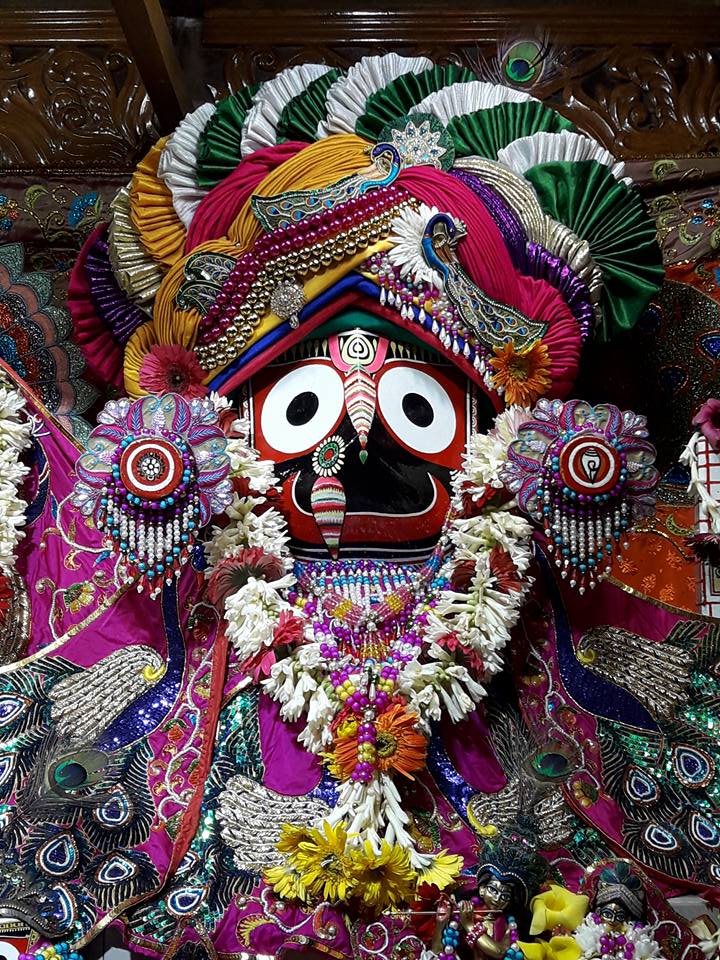
This article is to be read in conjunction with the previous article on how the wooden God was initially considered as narasiMha.
In quite a few Sanskrit works on the temple,we find the Lord of Puri being referred to as puruShottama. One might ask,what is the origin behind this name and why this particular name has been linked with jagannAtha historically? I am summarizing GC Tripathi’s work here
Early sAtavata conception
The early sAtavata conception of this term is noted in the 15th chapter of the Gita embedded in the Mahabharata,where kR^iShNa is identified as puruShottama,as beyond the kShara and akShara puruSha,and having an identity with them. Also the shloka that goes “…atō.smi lōkē vēdē ca prathitaḥ puruṣōttamaḥ৷” is indicative of Krishna-Vishnu being identified with the puruSha concept even in vaidika terms. In ritual that is extant even today,the puruSha sukta is used for worshipping viShNu in pUjAs that require 16 upAchAras(each of the mantras of the sukta being used for a particular upAchAra). That the fact this ritual is old is attested in the Bombay recension of the Skanda Purana.
puruShottama as used in early literary records and epigraphy of the Jagannath temple
- anargharAghava of murAri(circa 900s CE):puruShottama is described as being on the salt ocean and drawing patterns on the breasts of kamalA with paste of musk and His yAtrA.
- prabodhachandrodaya of kR^iShNamishra(was written between 1060-70CE) where the kShetra of puruShottama is referred to
- puruShottama mAhAtmya of the skanda purANa(1300s CE)
- mahApuruShavidyA(1600s CE?)
- Maihar inscription at a sarasvatI temple(middle of the 10th century)
- Dasgoba Copper plate grant of Rajarajadeva,recording the construction of the new temple of Jagannath Chodagangadeva.
puruShottama in tAntrika literature
Now that we have noted the earliest literary and epigraphical references to that term puruShottama,we should now turn to the tAntrika literature which has been influential in the usage of this term(and which has influenced the ritualism of the shrImandira) to understand what did the people in those eras mean when they said puruShottama(as already noticed in the anargharAghava,the deity is already alluded to as having an erotic component and is in play with lakShmI)
The aspects of puruShottama can be noted under the following headings in the shAradAtIlaka according to Tripathi
- puruShottama-trailokyamohana
- shrIkara-puruShottama
- kAma-puruShottama
- kR^iShNa gopijanavallabha
In later works like kramadIpikA of keshavabhaTTa(which has been influential on most of the existing pUjAvidhis of jagannAtha) and the gautamIya-tantra(one of the most influential Agamika texts on the worship of kR^iShNa) puruShottama is noted as puruShottama-bhuvanamohana and puruShottama-trailokyamohana and invoked in the former in a highly erotic form with the yonI of lakShmI getting wet due to amorous excitement and the divine couple being surrounded by thousands of damsels of devas,nAgas etc intoxicated and languid due to the effect of love,and the gautamIyatantra’s description of the couple has shrI embracing Him tightly seducing Him with amorous gestures(sakAmalIlAya devam mohayantI). In these texts,it is puruShottama alone who is referred to as jagannAtha,which facilitated the name interchangeability. Whereas,in earlier texts like the shAradAtIlaka,trialokyamohanA whose link with kAma is obvious in His gAyatrI,and the dhyAna as elaborated by rAghavabhaTTa who notes that lakShmI embraces(dakShiNena Ali~Nganam) Him,and His eyes are enlarged and languid,due to the effect of liquor:And worshipping Him grants the 4 puruShArthas of life;in the later two texts,kR^iShNa becomes prominent and the puruShottama aspect becomes reduced to usages in special rites,while the jagannAtha epithet of puruShottama acquired more and more popularity amongst even literature in the vernacular and the masses.
The testimony of the skandapurANa’s puruShottama mAhAtmya
The puruShottama mAhAtmya refers to subhadrA as lakShmI at three incidents(two of which are being cited here),and interestingly,when referring to events cited as happening in the hoary past.
- The incident of puNDarIka and ambarISha;two mahApApIs who could visualize jagannAtha as being with lakShmI who is offering Him a betel-leaf(5th adhyaya). Later too SHe is described as shrI standing between viShNu and shesha
- The 19th adhyaya explicitly pleads for the identification of the female deity as shrI(lakShmI),and not any fraternal identity
The testimony of the mahApuruShavidyA
This mahApuruShavidyA(also called puruShottama mAhAtmya) is a text which,according to Tripathi has been composed by shAkta brAhmaNas of the Sasana villages near Puri,who are also with a great affinity towards the Jagannath cult sometime around the 1500s. In this text,the female deity is almost invariably identified as lakShmI even under the mere name of subhadrA
vAmA~NgarUpiNIM lakShmIM tasya dakShiNapArShvagam|
apashyad divyayA dR^iShTyA subhadrArUpadhAriNIM||
And She sports with Her lord like an ordinary human being in the cave of the nIlAchala mountain(nIlAchalaguhAmadhye naralIlAvihAravAn…)
The actual temple layout and aspects of ritual
- The garbhagR^iha has space for two(and only two) deities[implying that yes,balabhadra was added later,this is a matter that will be dealt with in a future article] representing puruShottama and lakShmI
- These two deities were represented by (kAma)-puruShottama and lakShmI
- In existing ritual at the shrImandira:the pIThashaktis of kAma-puruShottama reappear as the mates of bhUvaneshvarI(the current identity of the deity known as ‘subhadrA’). The artificial form of the names of these deities signify that these were originally meant for the worship of kAma-puruShottama and not bhuvaneshvarI initially,and were readapted into Her yantra here at a later date. Also when lakShmI is considered to be of golden complexion when She is in union with puruShottama in the shAradAtIlaka,the same bodily complexion of the deity identified as subhadrA today,the possibility of the female deity having being considered as the sister of viShNu is unlikely to have been the historical conception of the deity initially.
- The yantra for pUjA for jagannAtha Himself is a mixture of the yantras of trailokyamohana-puruShottama and shrIkR^iShNa gopijanavallabha in the sense that a sexagon is central,but an 8-petalled lotus is involved,rather than the standard 10 petalled lotus for shrIkR^iShNa.
namo gopIjanavallabhAya|
